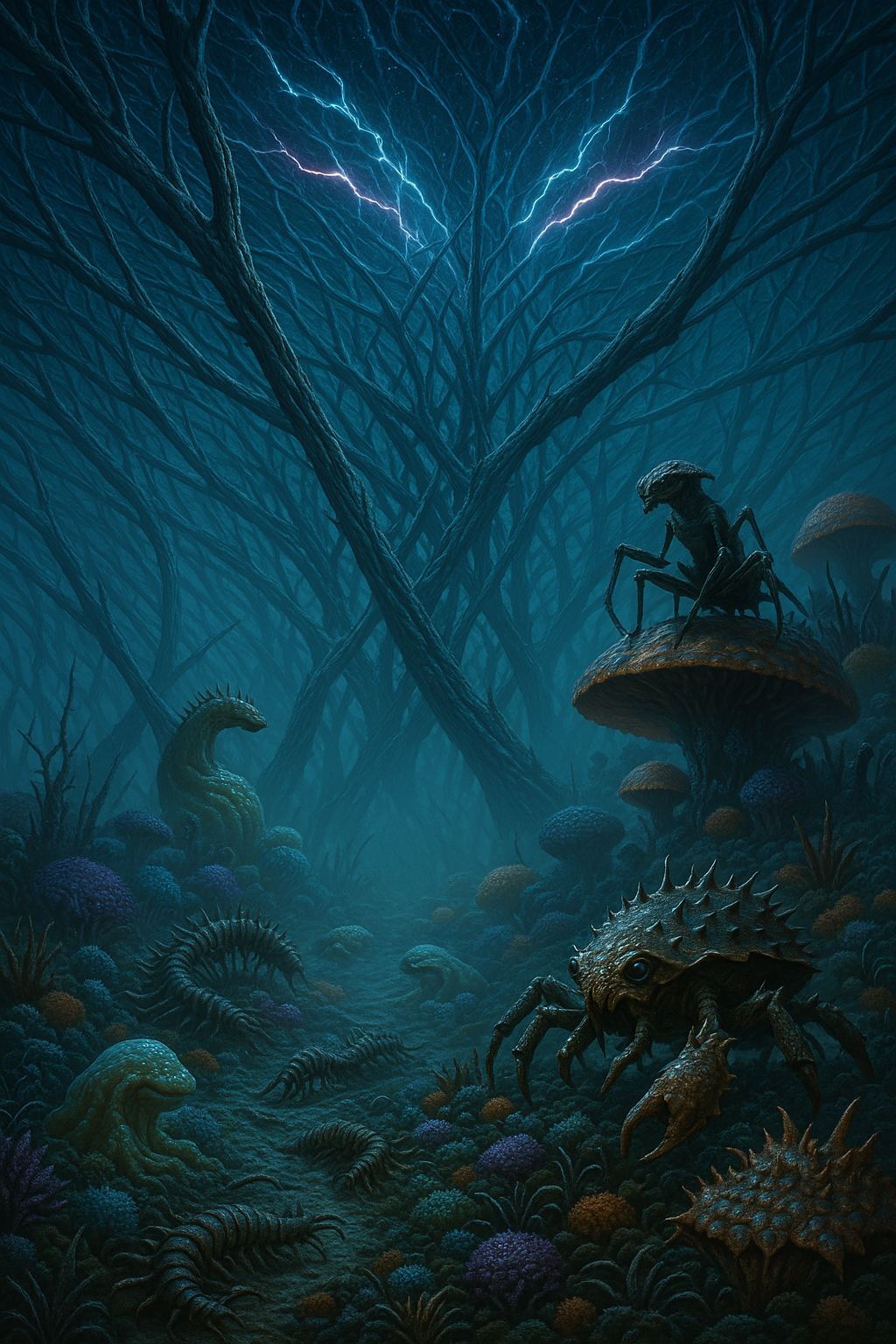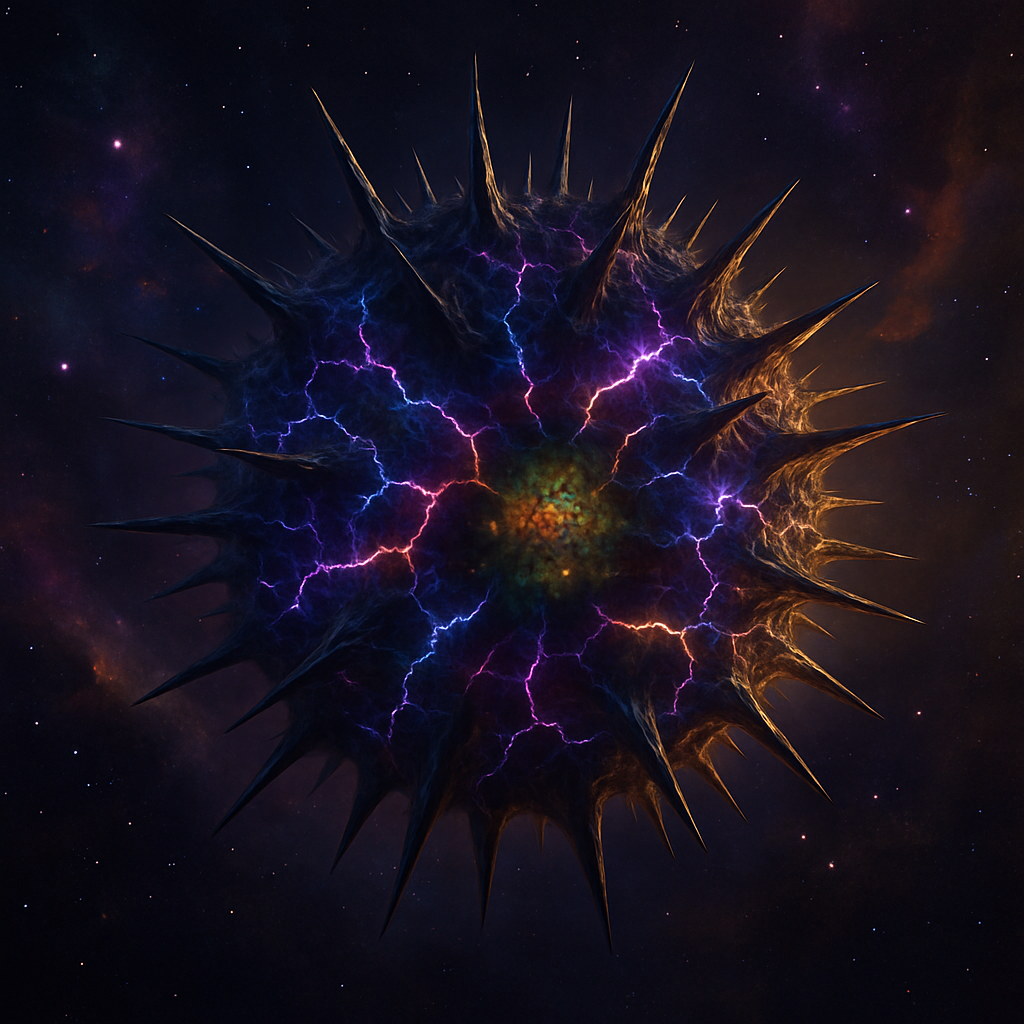Unnamed and Virtually Unknown Planet Far Away Elsewhere
Geography
The planet is on the smaller side, with a molten core surrounded by a mantle comprised of metals and minerals.
The surface landscape is dominated by jagged, needle-like branches and spires—twisted veins of dark iron, iridescent steel, and semi-organic metal that seems to grow rather than erode, as well as other alien metals and minerals not existing on Tala'm. These structures burst forth from the ground in tangled, spiraling networks, interlacing high above the ground to create an oppressive canopy of interwoven metal arteries, some stretching upward for miles and forming what is essentially an additional outer two-thirds of planet radius. In a perspective from outer space, there are gaps extending down for miles from the open upper surface to the thriving surface far below.
The thriving surface: Over the course of millions of years, the surface gradually gathered enough organic material from space to form a softer crust and developed an atmosphere capable of sustaining plant and animal life.
The surface landscape is dominated by jagged, needle-like branches and spires—twisted veins of dark iron, iridescent steel, and semi-organic metal that seems to grow rather than erode, as well as other alien metals and minerals not existing on Tala'm. These structures burst forth from the ground in tangled, spiraling networks, interlacing high above the ground to create an oppressive canopy of interwoven metal arteries, some stretching upward for miles and forming what is essentially an additional outer two-thirds of planet radius. In a perspective from outer space, there are gaps extending down for miles from the open upper surface to the thriving surface far below.
The thriving surface: Over the course of millions of years, the surface gradually gathered enough organic material from space to form a softer crust and developed an atmosphere capable of sustaining plant and animal life.
Ecosystem
There is an atmosphere for breathing, life-sustaining liquid in the air, and lower gravity than Tala'm.
Settlements are built in and around the branches of metal, and most animals live far below the upper surface, down where there is dirt, vegetation, and fluid reserves.
A fungal communicative network has wriggled and forced its way through the stiff material of the mantle over centuries of growth.
Settlements are built in and around the branches of metal, and most animals live far below the upper surface, down where there is dirt, vegetation, and fluid reserves.
A fungal communicative network has wriggled and forced its way through the stiff material of the mantle over centuries of growth.
Localized Phenomena
In the upper level, bolts of multicolored lightning often dance around among the metal branches of the canopy surface and create quite a spectacle. They are dangerous around the immediate area, with some of the metals also conducting the electricity much further down below the storms, but the electrical currents become blocked or do not build up enough charge to cause measurable harm down as far as the thriving surface.
Climate
The planet's lower atmosphere, where violet clouds and flickering storms journey, churns with static and spore-laden mist.
High humidity and temperatures can reach 280° F, but the liquid does not boil. Temperatures can reach as low as 47° F during a solar cycle. The liquid never freezes or turns to snow.
One day is the equivalent of 11.2 Tala'm days.
High humidity and temperatures can reach 280° F, but the liquid does not boil. Temperatures can reach as low as 47° F during a solar cycle. The liquid never freezes or turns to snow.
One day is the equivalent of 11.2 Tala'm days.
Fauna & Flora
Far beneath the canopy of metal branches lies a shadowy underworld teeming with vegetation, most of it unlike any found on Tala'm. Thick mats of spiked vines, fuzzy stalks, and bulbous fungi blanket the ground, coated in shimmering molds and slick bioluminescent slime. Some species of flora can even sense animals and move to swallow or entangle them, secreting enzymes to dissolve the bodies into the nutrients they need to flourish. With the humidity, there are a large variety of molds and fungi. Several breeds of mushrooms glow from beneath, casting soft halos of orange, cyan, violet, or sulfurous green through the mist, and supplying much needed lighting for during the long nights with no moon to illuminate. Air currents carry luminescent spores that drift slowly between the structures, giving the jungle a constant feeling of motion, breath, and watchfulness.
The native fauna are equally alien; nightmarish in form while adaptive in function. Massive centipede-like creatures, with chitinous armor and grasping mandibles, carve paths through the undergrowth. Some lifeforms seem to ooze rather than walk; slime-based organisms that shift form as they move, flowing through cracks in metal like water given thought. Others lurk above; multiple limb-laden predators with protective shell growths, multi-faceted eyes, and unsettling asymmetry cling to the metallic spires and pathways. Most have adapted to electrical shocks and hunt among the metal branches, making homes in the nooks and watching for their next unsuspecting meal. With the lower gravity, it is easier for them to leap between the branch spires and even have entire fights with their prey while airborne.
The native fauna are equally alien; nightmarish in form while adaptive in function. Massive centipede-like creatures, with chitinous armor and grasping mandibles, carve paths through the undergrowth. Some lifeforms seem to ooze rather than walk; slime-based organisms that shift form as they move, flowing through cracks in metal like water given thought. Others lurk above; multiple limb-laden predators with protective shell growths, multi-faceted eyes, and unsettling asymmetry cling to the metallic spires and pathways. Most have adapted to electrical shocks and hunt among the metal branches, making homes in the nooks and watching for their next unsuspecting meal. With the lower gravity, it is easier for them to leap between the branch spires and even have entire fights with their prey while airborne.
Show spoiler
There is one other species of particular note. These parasitic predators were born on the planet thousands of years ago, but are very much an invasive species, their eggs having been released into the atmosphere by a giant space blob as it passed by. Similar to their parent, they have a translucent blobby form with color dispersal sacs and the ability to alter their form to mimic any creature, plant, or object they choose to. By far, they are the apex predator and have developed as the only ones on the planet with an advanced civilization, and a way of creating what they want into existence that is all their own.




Comments